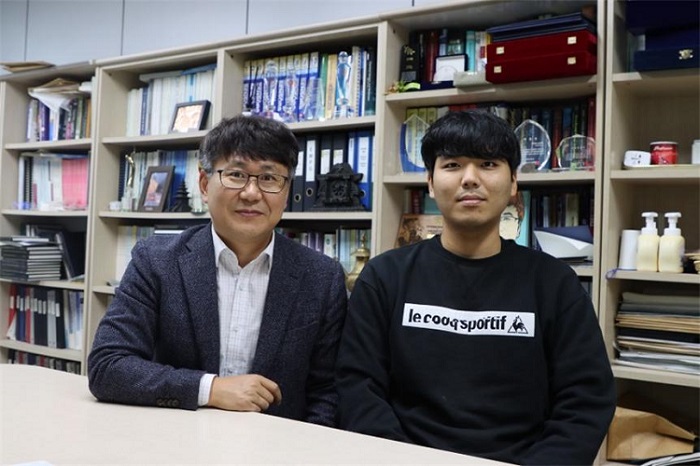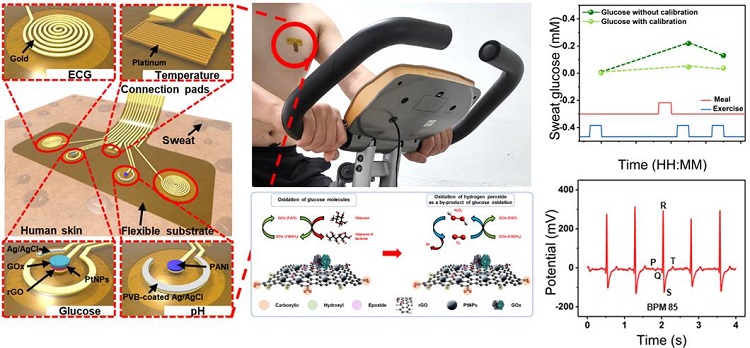Prof. Park Jae-Young’s Team Develops a Skin Patch Sensor That Simultaneously Measures Blood Sugar...
- admin
- 2021-11-18
- 2516
Professor Park Jae-Young’s Team Develops a Skin Patch Sensor That Simultaneously Measures Blood Sugar and ECG
Professor Park Jae-Young's research team (Department of Electronic Engineering) has succeeded in developing a 'multifunctional hybrid skin patch sensor for wearable smart medical and healthcare systems'. The patch sensor developed by his research team is capable of non-invasive blood sugar monitoring and continuous electrocardiogram measurement through accurate sweat sugar detection.

Professor Park Jae-Young (left) and Yoon Sang-hyeok (right)
Recently, as the interest and importance of metabolic syndrome and chronic disease management due to westernized diet and aging continues to increase, the need for wearable smart medical and healthcare systems using bio signal real-time monitoring technology is greatly increasing. Therefore, research on patch sensor technology that can non-invasively monitor the user's chemical bio signals (blood sugar, lactate pH, etc.) and physiological signals (electrocardiogram, electromyography, brainwave, etc.) in real time is being actively conducted at home and abroad.
In particular, sensor technology for measuring and real-time monitoring of blood glucose in bodily fluids such as tears, sweat, and interstitial fluid (ISF) is being studied the most. However, most of the patch sensor-related studies reported so far are technologies that measure only chemical bio signals or physiological signals, and there is a limit to the application of next-generation smart health care and disease diagnosis systems that require complex and multiple bio signals. Also, since blood sugar obtained from sweat is affected by temperature and pH, it is essential to correct it.
The research team developed a hybrid path sensor which is a new concept that can simultaneously measure body temperature, chemical bio signals (blood sugar, pH), and physiological signals (electrocardiogram, electromyography) by overcoming the pain caused by frequent blood collection and the inconvenience of attaching multiple patch sensors to the body. It is a multi-flexible patch sensor that integrates several electrochemical and physiological sensors on one flexible substrate so that the temperature and pH correction sensors are integrated with the sweat sensor to accurately detect blood glucose from sweat and continuously measure electrocardiograms. After applying a two-dimensional nanomaterial, reduced graphene oxide (rGO) thin film, on the micropatterned electrode, the surface characteristics analysis and material and device process conditions are optimized through physical/chemical property data (Cyclic voltammetry, FE-SEM, XPS). The performance of the sensor is greatly improved.
The developed blood glucose sensor showed high linearity (R2=0.99) and sensitivity (29.10 ?A mM?1cm?2) within the effective range of the body. It showed similar characteristics. In addition, as a result of conducting an on?body test based on human sweat, the validity of the hybrid skin patch sensor manufactured by comparison with commercial skin analysis equipment was verified. The skin patch sensor developed in this study is greatly used in research for smart management of chronic diseases and metabolic syndrome through big data analysis and the establishment of a u? healthcare DB through various complex biometric information collected based on wearable medical and healthcare platform technology.
Meanwhile, this research was carried out with the support of the Biomedical Technology Development Project (NRF-2017M3A9F1031270) of the Ministry of Science and ICT. and Bioelectronics, (IF:10.618) https://doi.org/10.1016/j.bios.2021.113685

Hybrid skin patch sensor and measurement results for wearable smart medical and healthcare applications